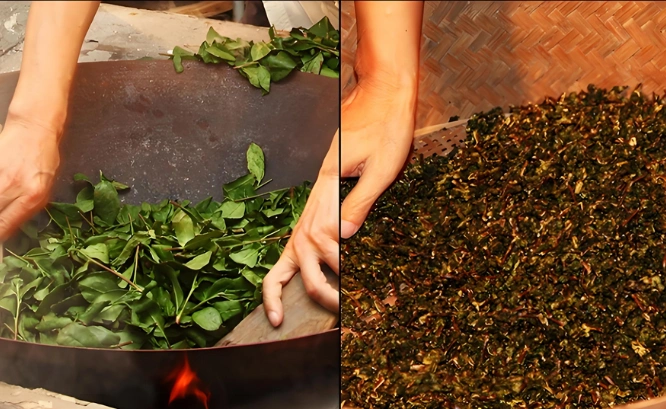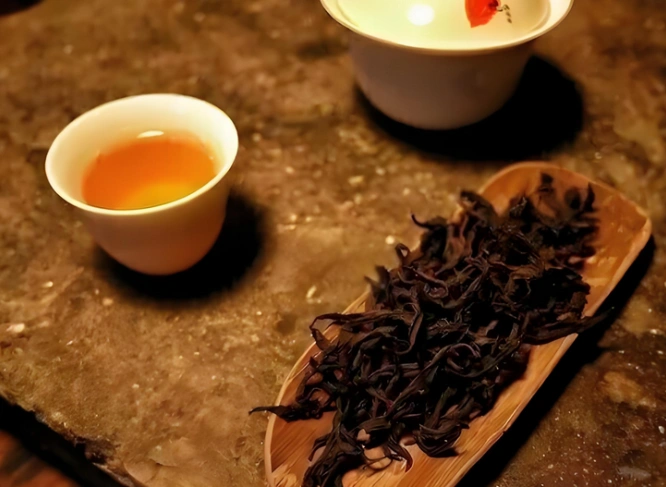Oolong tea in Chinese culture is more than a beverage—it’s a living legacy that weaves together history, art, and everyday harmony. Imagine sitting beside a lotus pond in Fujian, watching sunlight dance on jade-green leaves as they unfurl in steaming water. You inhale orchid-sweet aromas and taste layers of honeyed fruit and mineral depth. From the misty Wuyi cliffs to modern urban teahouses, oolong tea in Chinese culture infuses each moment with mindfulness, connection, and reverence.
In this exploration, we’ll journey through its origins, ceremonies, regional styles—such as Fujian’s Tieguanyin, Guangdong’s Phoenix Dan Cong, and Wuyi rock oolong—then delve into its roles in meditation, travel, and global influence. Prepare to savour the essence of China’s revered tea tradition.
1. Origins & History: From Wuyi Mountains to Global Renown
The story of oolong tea in Chinese culture begins over a thousand years ago in Fujian Province. According to legend, farmers stumbled upon partially oxidized leaves that delivered the best of green and black teas. By the Ming dynasty (14th–17th centuries), tea masters refined processing—sun withering, tossing, partial oxidation—creating the “black dragon” or wulong (乌龙). The famed Wuyi Mountains, shrouded in morning mist, became the cradle for robust rock oolongs, prized for their mineral “rock rhyme” (岩韵). Trade routes, including the Maritime Silk Road, carried these fragrant teas overseas, cementing oolong tea in Chinese culture as both a domestic treasure and international ambassador.

2. Traditional Tea Ceremonies: Oolong Tea in Tea Ceremonies
In Chinese tea art, every gesture matters. Oolong tea in tea ceremonies—especially the Gongfu (功夫) style—celebrates precision and sensory immersion. A small clay teapot or gaiwan is warmed; 5–8 g of leaves are measured with care. The first quick rinse releases the tea’s spirit, then successive infusions, each 10–30 seconds, unfurl nuanced aromas. The host pours into tiny porcelain cups, allowing guests to admire the liquor’s hue—amber, jade, or deep auburn—and inhale fragrances of orchid, honey, or roasted cocoa. This ritual isn’t mere formality; it’s a meditation in motion, fostering respect for nature, the leaf, and one another.
3. Regional Styles & Their Cultural Significance
Fujian’s Tieguanyin
Born in Anxi County, Tieguanyin (铁观音) dazzles with orchid florals, creamy mouthfeel, and gentle sweetness. Its name—“Iron Goddess of Mercy”—reflects reverence, linking the tea to Buddhist compassion. Locals hold harvest festivals celebrating the first spring pluck, underscoring oolong tea in Chinese culture as both spiritual and agricultural heritage.
Guangdong’s Phoenix Dan Cong
In Guangdong’s Phoenix Mountain, Dan Cong (单丛) bushes yield singular cultivars—each bush a unique variety with notes of lychee, cinnamon, and honey. Grown among phoenix trees, the tea symbolizes rebirth and grace. Families pass down Dan Cong knowledge through generations, preserving terroir wisdom in every fragrant leaf.
Wuyi Rock Oolong
High on Wuyi’s rocky cliffs, mineral-rich soils impart a slate-like depth to roasted oolongs like Da Hong Pao (大红袍). This “Big Red Robe” tea, once reserved for emperors, epitomizes oolong tea in Chinese culture as a symbol of status, tradition, and the unbreakable bond between land and leaf.
4. Health & Mindfulness: Oolong Tea for Yoga Meditation
Beyond ceremonies, oolong tea for yoga meditation has gained popularity among wellness seekers. Its moderate caffeine (30–50 mg per cup) and L‑theanine content promote alert calm—ideal for gentle morning flows or seated breathwork. A small study found L‑theanine boosts alpha brain waves, encouraging relaxation without drowsiness【1】. Sipping oolong mindfully, participants report enhanced focus and an elevated mind-body connection, reflecting the tea’s ancient role as both tonic and tonic of the spirit.

5. Oolong Tea for Travel: A Companion on the Silk Road and Beyond
Merchants, pilgrims, and explorers long carried oolong along winding trails. Oolong tea for travel offered warmth, hydration, and a taste of home. In teahouses along the Silk Road, guests received hot cups while caravans paused for rest. Today, modern travelers pack portable oolong sachets or small tins of Tieguanyin and Phoenix Dan Cong—inviting the ritual of oolong tea in Chinese culture into hostel common rooms and mountain refuges worldwide. This portable tradition reminds us that wherever the road leads, a moment of tea brings grounding and connection.
6. Modern Fusion: Oolong in Contemporary Chinese Life
From high‑end Shanghai tearooms to street‑corner bubble tea stands, oolong thrives in modern reinvented forms. Baristas craft oolong lattes topped with creamy foam; mixologists infuse oolong into cocktails alongside lychee and jasmine. Urban cafés host “tea yoga” sessions, pairing asanas with curated oolong flights. Tech startups gift employees artisanal oolong sets to encourage mindful breaks. These innovations demonstrate how oolong tea in Chinese culture evolves—honoring tradition while embracing contemporary lifestyles.
7. Preparation Rituals: Gongfu Style and Everyday Brewing
For aficionados, the Gongfu ritual remains the gold standard. Yet busy households adopt simpler methods: steep 2 g loose oolong per 6 oz water at 190 °C for 2–3 minutes, or use a teabag for convenience. Cold brew—5 g leaves per 500 ml water, refrigerated 8 hours—yields a smooth, low‑caffeine infusion ideal for hot summers. Regardless of method, each cup is a quiet homage to oolong tea in Chinese culture, connecting daily life to centuries of tea wisdom.

8. Symbolism & Ritual: Oolong at Festivals and Family Gatherings
Every Chinese festival features tea. During Lunar New Year, elders offer oolong to welcome prosperity; Mid‑Autumn reunions begin with fragrant brews symbolizing unity. At weddings, tea ceremonies honor ancestors and bless newlyweds. These customs underscore oolong tea in Chinese culture as a bridge between past and present, community and individual, joy and reflection.
9. Global Influence: How Chinese Oolong Shapes World Tea Culture
As oolong crossed oceans, it reshaped tea traditions globally. Japanese tea artists studied Gongfu techniques; Western sommeliers craft oolong pairing menus alongside cheese and chocolate. Health research on oolong’s polyphenols—such as EGCG—highlight cardiovascular and metabolic benefits【2】. International tea festivals celebrate Chinese oolong alongside world teas, cementing its status as a cultural ambassador. Wherever tea is cherished, the spirit of oolong tea in Chinese culture lives on.
10. Conclusion & Call to Appreciation
Oolong tea in Chinese culture is a dynamic tapestry: historic, spiritual, sensory, and ever‑evolving. From Wuyi’s rocky terraces to high-tech city lounges, each cup carries ancient wisdom into the present. Next time you pour hot water over curled leaves, pause to notice color, aroma, and flavor—then reflect on the hands and hearts that stewarded this tradition across millennia. Share your oolong discoveries, whether in ceremony, meditation, or travel, and join the global community that honors this living legacy—one fragrant sip at a time.



